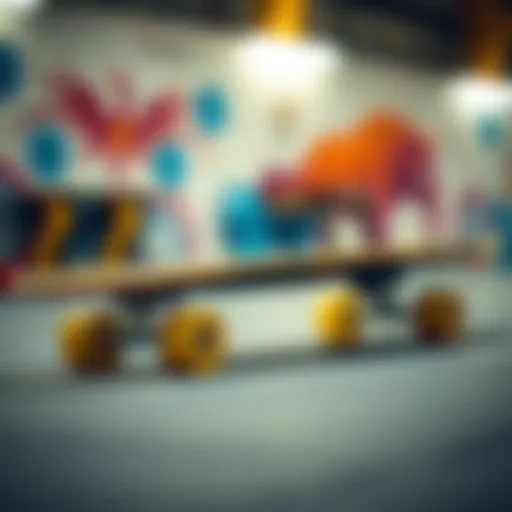Vans vs. Tiger Shoes: A Deep Dive into Skate Culture
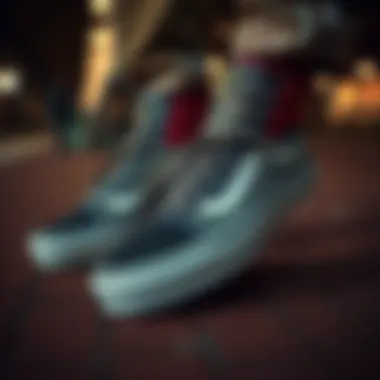
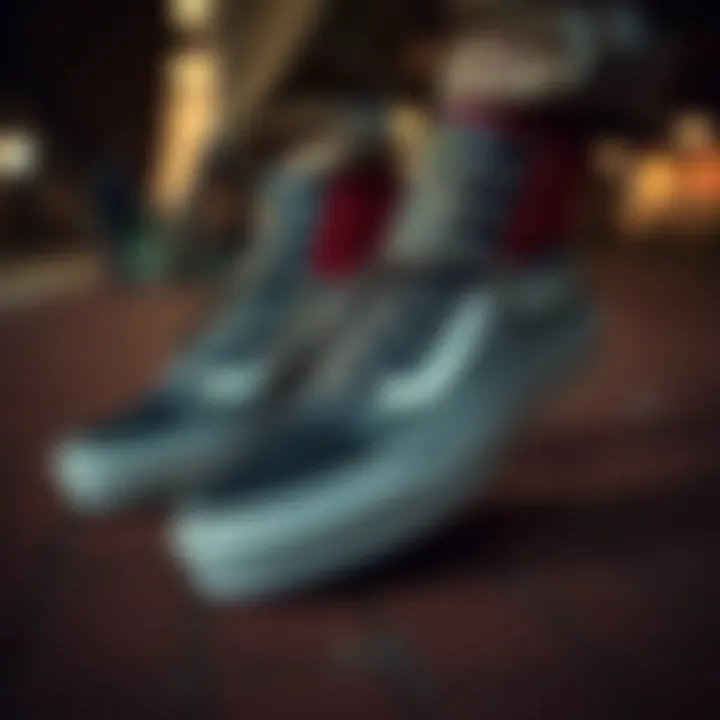
Intro
The universe of skate culture is vibrant and diverse, a patchwork quilt stitched together by passion, creativity, and a thirst for thrill. Among the key players in this realm are Vans and Tiger shoes, both of which have become synonymous with skateboarding. Their journey through the annals of skate history is anything but mundane. Each brand carries its own unique story, aesthetics, and ethos that resonate with skaters around the globe.
Vans, with its roots dating back to 1966, struck gold by marrying functionality with style. The iconic checkerboard pattern has not only graced the feet of countless skaters but has also become a hallmark of youth culture. Meanwhile, Tiger shoes, often praised for their innovative designs and comfort, have carved out a niche among enthusiasts who prioritize performance without sacrificing flair.
This exploration isn’t just a rundown of shoe choices; it’s about understanding how these brands intertwine with the very fabric of the skating community. From their tailored designs that can handle the rigors of daily trick attempts to the collaborations that push the boundaries of style, the dynamics at play are worth dissecting.
In this piece, expect a deep dive into the tricks and techniques that skaters employ while adorned in their favorite footwear, along with a look into the gear and equipment that complements their skateboarding experience. Whether you’re a seasoned pro or a novice trying to find your footing, understanding the significance of these brands can help enhance your connection to skate culture. A pairing of style and substance governs how skateboarders choose their shoes, and we aim to shed light on the influences that make up this fascinating intersection.
Prelude to Skate Footwear
Understanding skate footwear is like opening a door to the very heart of skate culture. It's not just about the shoes; it’s about identity, style, and the evolution of a subculture that has fiercely embraced individuality and innovation. This section lays the groundwork for appreciating how two pivotal brands, Vans and Tiger Shoes, have carved their niches within this vibrant community.
The significance of skate footwear transcends mere functionality. These shoes have become symbols of self-expression, resilience, and belonging. Skaters are very particular about the shoes they wear during an exhilarating ride on the board. The right pair can make the difference between a smooth trick and a hard fall. With that, understanding the intricacies of skate shoes is essential for anyone looking to dive into the lore of skateboarding. It’s about grasping how aesthetics, technology, and culture intertwine, shaping both the design and user experience.
Defining Skate Culture
Skate culture is more than just a hobby; it's a lifestyle that encompasses attitudes, fashion, music, and even philosophy. It emerged as youth sought freedom from conventional sports and found new ways to express creativity. This counterculture rose to prominence in the late 20th century, particularly in California, but its reach is global now, stretching from urban streets to sprawling skate parks.
The language of skate culture is rich with slang and gestures that reflect its unique ethos. Skateboarding has grown to symbolize defiance and innovation, challenging societal norms. It serves as a canvas for individuality, a place where skaters can showcase their skills and share their stories. Moreover, community plays a critical role, as skaters often rally together, sharing tips, tricks, and inspiration at local spots and competitions.
The Evolution of Skate Shoes
Over the decades, skate shoes have experienced a remarkable transformation, paralleling the evolution of skate culture itself. In the early days, skaters wore anything from tennis shoes to heavy work boots. This hodgepodge of styles paved the way for brands to innovate specifically for skateboarding, leading to the birth of specialized skate footwear.
- 1970s: This decade marked the inception of many now-iconic brands. Vans introduced the Slip-On, which offered skaters a low-profile and durable option that quickly became a favorite.
- 1980s: The explosion of skating’s popularity prompted brands to rethink designs for performance. Padded tongues and durable materials became standard to withstand the rigors of trick skating.
- 1990s and beyond: Footwear technology advanced, with features that enhanced grip and support. Skaters began to prioritize not just durability but also style, resulting in colors and designs that spoke to their unique identities.
This journey reveals how functional needs drove design but also how shoe aesthetics became a crucial part of skate culture. Fashion statements and endorsements from pro skaters have transformed footwear into collectibles, each pair telling its own story.
"In skate culture, your shoes are not just about skating; they represent who you are."
From the humble beginnings of skate shoes to the high-performance models we see today, the evolution reflects a blend of creativity, functional design, and cultural significance that continues to influence how skaters choose their footwear.
The Legacy of Vans
The legacy of Vans is woven into the very fabric of skate culture, acting as both a cornerstone and a catalyst for the sport's evolution. Founded in 1966, the brand has transcended mere footwear; it represents a lifestyle deeply rooted in creativity, freedom, and individual expression. The compelling narratives of artists and athletes wearing Vans have helped solidify its status in the skateboarding community. This legacy offers rich insights into why Vans continues to capture the hearts of skaters, generations later.
Founding and History
The story begins in California, when brothers Paul and Jim Van Doren opened the first Vans store in Anaheim. From the outset, the mission was clear: create durable and functional shoes for skaters. The Vans #44, known today as the Old Skool, was one of the initial offerings and featured that iconic side stripe, a design element that remains synonymous with the brand. The Vans ethos blended seamlessly with the Southern Californian skater lifestyle, leading to a growing community that appreciated not just the quality but also the effortless street style.
Interestingly, it was the skateboarders themselves who played a crucial role in shaping the brand’s identity. Early adopters took to customizing their shoes with unique designs or signatures, propelling a culture of individuality that Vans fully embraced. By the 1980s, the brand had gained notoriety among skateboarders and surfers, marking its undeniable impact on both subcultures.
Iconic Models Throughout the Years
Vans' portfolio is filled with models that have left an indelible mark on the industry. Here are a few standout examples:
- Old Skool: This model combined aesthetics with functionality, designed specifically for better grip on the board. It’s a perennial favorite that's stood the test of time, evolving while still holding onto its classic roots.
- Sk8-Hi: Introduced in 1978, this was one of the first high-top skate shoes, offering added ankle support for skaters. Its design has inspired countless iterations over the years.
- Slip-On: With its laid-back vibe, the Slip-On became a staple not only in skate parks but also on runways and city streets, showcasing the brand’s versatility.
These models encapsulate a journey of innovation and style, highlighting how Vans continually adapts to the ever-changing landscape of skateboarding.
Vans in Skateboarding Culture
In skateboarding culture, Vans is more than just a footwear brand—it's a symbol of rebellion, creativity, and community. The brand has consistently aligned itself with the sport, sponsoring major events like the Vans Warped Tour and the Vans US Open of Surfing. These events serve as platforms that highlight not only the competitive spirit among the riders but also emphasize the artistic side of skate culture.
The unique collaboration with influential skaters to develop signature shoes is another testament to Vans’ deep involvement in this realm. When skaters like Tony Hawk or Steve Caballero put their name on a Vans model, it goes beyond mere endorsement.
"A skateboarder isn't just a person who rides a board; they're a part of a culture that thrives on expression. Vans has been a significant supporter of that ethos, making its mark not just through shoes, but through the lifestyle they promote."
Moreover, the presence of Vans in skateboarding films, music videos, and fashion showcases further cements their legacy, allowing the brand to remain ever-relevant.
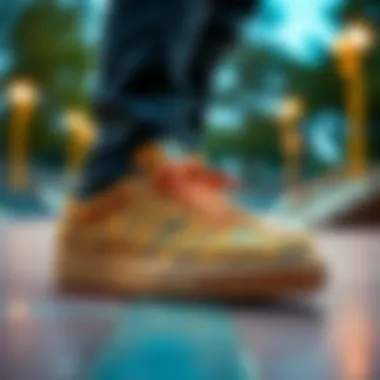
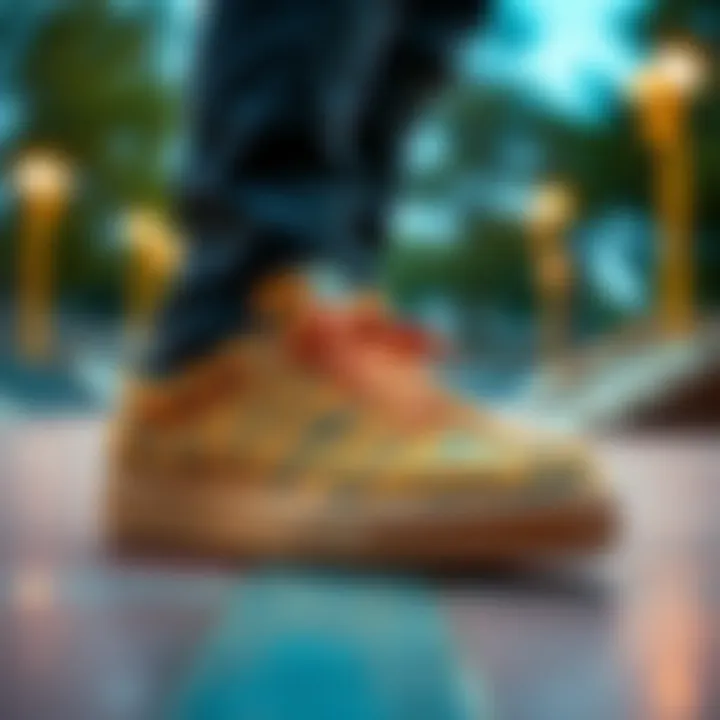
In summary, the legacy of Vans is a rich tapestry of history, innovation, and cultural significance. As they continue to influence current trends in skateboarding, it is apparent that Vans will remain a central figure in the world of skate culture for years to come.
An Overview of Tiger Shoes
Understanding the unique position of Tiger shoes within skate culture is pivotal to grasping the broader dynamics at play with various footwear options available to skateboarders. Tiger shoes aren't just an alternative; they represent a fusion of sporting heritage, innovative design, and cultural relevance. By examining this overview, we get a glimpse into how Tiger shoes have carved a niche that captivates skaters and enthusiasts alike, illustrating their significance in the footwear landscape.
Brand Origin and Development
Tiger shoes, the brainchild of the Onitsuka Tiger brand, emerged from Japan in the early 1940s. Initially produced for track athletes, these shoes quickly evolved. As skate culture burgeoned in the late 20th century, the brand adapted to the ever-changing tastes and demands of skateboarders. The shoes became synonymous with a certain rugged charm that appealed to both casual skaters and hardcore enthusiasts. In today’s market, Tiger footwear stands out for its unique blend of vintage aesthetics and modern functionality, appealing to skaters who appreciate both style and performance. This transition from sports shoes to skate-ready designs showcases the brand's astute awareness of cultural trends.
Design Innovations and Performance
In terms of design, Tiger shoes are notable for their attention to detail and functional style. They often feature a minimalistic, yet distinct, silhouette. The materials used, such as durable canvas and leather, ensure they remain tough, standing up to the rigors of daily skating. Recent innovations have focused on improving grip and cushioning, providing skaters with a sense of safety as they push their limits. Features like reinforced toe caps and padded collars enhance not just durability but also comfort during action-packed sessions. Many proponents argue it’s this very blend of comfort and grit that makes Tiger shoes a worthy contender in the skate market.
Tiger Shoes in the Skateboard Scene
When you look closely, the influence of Tiger shoes in the skateboard scene is undeniable. Although Vans often grab the spotlight, Tiger’s unique offerings attract a niche following. Their designs appeal not just to skaters but also to those who appreciate the aesthetic of skate culture. Local skate shops often recommend them for their less mainstream status, drawing riders who are looking for something slightly different. The styles available often reflect skate fashion trends, serving as a statement piece on and off the board. On platforms like Instagram, the sight of skaters donning Tiger shoes becomes a testament to their growing acceptance within the community. Ultimately, while they might not be the first choice for every skater, their presence cannot be overlooked when painting a complete picture of skate footwear culture today.
"Tiger shoes may not flood the skate parks like Vans, but they carve out their lane, representing a distinct subculture within skating."
Relevant Resources:
- Onitsuka Tiger Brand History
- Skateboarding History
- Skate Shoe Trends on Reddit
- Urban Culture and Footwear
Let's delve deeper into these elements to illuminate the rich tapestry of Tiger shoes and their role in skate culture.
Comparative Analysis of Vans and Tiger Shoes
The discussion surrounding Vans and Tiger shoes remains pivotal in revealing not just the inherent styles of the brands but also their broader influence within skate culture. With skaters often prioritizing both functionality and aesthetic appeal, understanding how these two brands stand up to each other can illuminate trends and preferences prevalent in the skateboarding community.
Design Philosophy
When examining the foundational design philosophies, Vans and Tiger shoes offer contrasting yet complementary perspectives. Vans has made its mark with a minimalist approach, focusing on clean lines and a skate-ready canvas that resonates deeply with the simple yet rebellious spirit of skaters. Classic designs like the Old Skool and the Slip-On are not just fixtures; they’re statements. The easy wear and iconic checkerboard patterns echo an authenticity that appeals to both professionals and amateurs alike.
On the flip side, Tiger employs a more eclectic design strategy. Known for its vibrant colors and distinctive logos, Tiger shoes cater to those who blend funk with functionality. Each shoe seems to narrate a story, often pulling from various influences across music and fashion, creating narratives that skaters resonate with. A motif of urban flair is common in Tiger's offerings, which attract those looking to project individuality while skating.
Footwear Technology
Diving into footwear technology, both brands provide unique features that cater to skateboarding needs. Vans uses proprietary cushioning systems like UltraCush, ensuring that riders stay comfortable during those long sessions. The grip of their gum rubber soles is legendary, often highlighted in testimonials from avid skaters who swear loyalty to the brand for its performance.
Meanwhile, Tiger shoes incorporate advanced shock absorption techniques. Models like the Mexico 66 utilize lightweight materials that not only reduce foot fatigue but also enhance agility. This attention to detail and innovation means enhanced board feel, a critical element when performing tricks that require precision. The juxtaposition of these technologies speaks to how each brand interprets performance in its respective way.
User Preference and Comfort
Comfort can make or break a skate session, and it's no wonder skaters are often vocal about their preferences. Many skaters favor Vans for their straightforward fit. Known for the reliable sizing and the durability of their materials, these shoes often mold to the wearer’s foot over time, providing a level of comfort that's hard to match. There’s something to be said for slipping into a well-worn pair, knowing they’ve been through the grind just like you have.
In contrast, Tiger shoes, while comfortable, often fit differently due to their unique construction methods. They may require a breaking-in period, but once they conform, they offer an almost customized feel. Skaters who embrace this aspect tend to appreciate the distinctive look that Tiger brings, which can lend an extra ounce of confidence on the board. It often boils down to personal preference, with each skater choosing the brand that aligns better with their skating style and vibe.
"The choice between Vans and Tiger isn’t just about aesthetics; it's a reflection of one’s skating identity and approach."
In summation, the comparative analysis of Vans and Tiger shoes paints a broader picture of the skate culture landscape. As much as these brands shape the footwear market, they also illustrate how footwear is an essential part of a skater's identity, reflecting their personal taste and approach to the sport. By exploring elements like design philosophy, technology, and user comfort, skaters are better equipped to make informed choices that not only enhance their performance but also express their individual flair.
Style and Aesthetic Considerations
Skate shoes aren’t just about functionality; they are also a canvas for personal expression and cultural representation. In this section, we dive into how the styles and aesthetics between Vans and Tiger shoes play a crucial role in their appeal among skateboarders. These visual aspects influence choice, encourage brand allegiance, and reflect broader lifestyle trends within the skate culture community. Skateboarding is as much about what you wear as how well you ride, leading to a connection between style and identity that carries significant weight.
Vans: Classic and Contemporary Styles
Vans has built a treasure trove of iconic shoes that blend timeless designs with contemporary flair. The classic checkerboard slip-ons, for example, are practically synonymous with skate culture and evoke nostalgia paired with modern attitudes. This balance is achieved through consistent elements such as durable canvas, thick rubber soles, and a variety of colorways.
Here’s how Vans achieves its appeal:
- Heritage: The legacy of Vans is threaded through its designs, where older styles still resonate with newer generations.
- Adaptability: Contemporary releases often reinterpret old classics. For instance, the new Pro Skate line retains the look of traditional Vans but enhances performance features.
- Customizability: Vans allows for creative expression via customization, something many skateboarders embrace eagerly. Personalization possibilities invite skaters to showcase individuality, encouraging the reimagining of classic silhouettes.
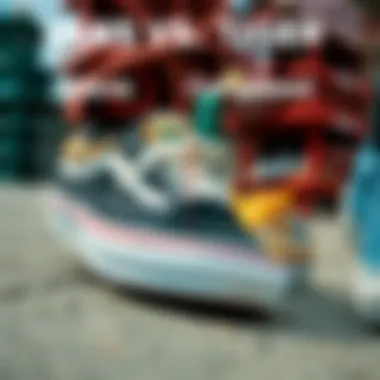
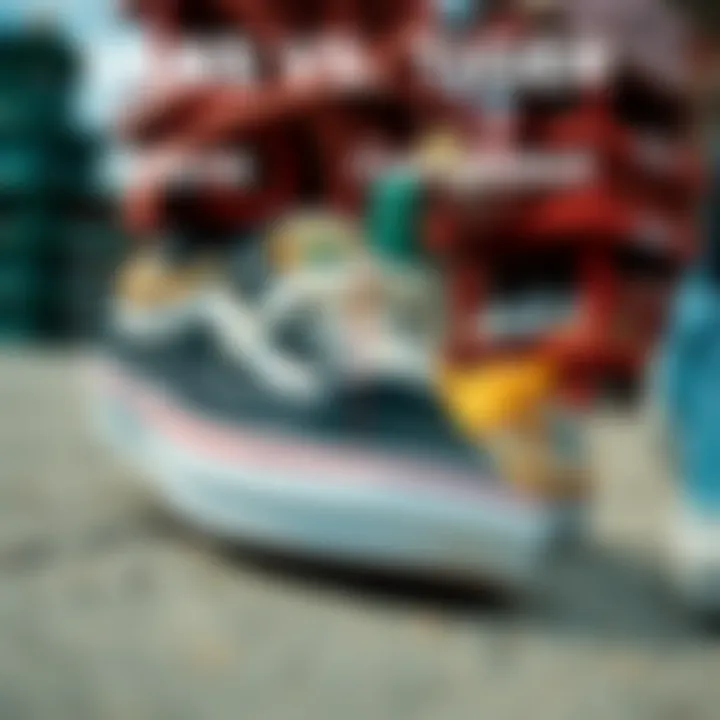
The Unique Aesthetic of Tiger Shoes
Tiger Shoes carve out their own niche by mixing performance-oriented features with unique visual elements. While Vans tends to lean towards established cultural imagery, Tiger emphasizes innovation through its designs. Bright colors, bold patterns, and unexpected materials define Tiger’s shoes, making them a striking choice on the skate park scene.
The aesthetic qualities are grounded in:
- Diversity: With a range of shoes that cater to various skating disciplines, Tiger Shoes offer familiarity without sacrificing funkiness.
- Innovation: New materials and construction techniques lead to designs that stand out aesthetically and functionally.
- Cultural Relevance: Tiger’s designs often reflect urban lifestyle influences, merging streetwear and skate culture seamlessly.
The Role of Aesthetics in Skate Culture
Aesthetics weave a deep narrative in the fabric of skate culture. Shoes are the unsung heroes that bridge the gap between performance and style, whereby skateboarders often face choices influenced by both practical needs and personal taste. Consider this:
- Identity: Wearing a certain brand can create a sense of belonging within the community. The right aesthetics often communicate status or affiliation.
- Expression: As skateboarders push boundaries, their footwear choices often reflect their individual personalities and philosophies. Shoes become an extension of who they are.
- Social Influences: The impact of social media further amplifies the importance of aesthetics, with stylish sneaker options receiving more visibility across platforms like Instagram and TikTok.
The dialogue about shoes in skate culture goes beyond mere practicality; it touches on style, identity, and community. Brands like Vans and Tiger Shoes illustrate how important these elements are by creating products that resonate deeply with skaters. Wearers aren’t just choosing footwear; they are declaring a part of who they are.
"Style is a way to say who you are without having to speak." - Rachel Zoe
Collaborations and Limited Editions
In the realm of skate footwear, collaborations and limited editions hold a significant sway over consumer interest and brand identity. These partnerships often bring fresh perspectives and innovative designs that resonate with the skater community. When a brand collaborates with artists, designers, or even popular culture entities, it becomes an opportunity to create something unique that stands apart in the crowded market.
From a consumer standpoint, limited editions generate a sense of exclusivity, enticing skateboarders and collectors alike. This exclusivity cultivates a feeling of belonging to a select group, where wearing a particular sneaker can signify more than just a fashion choice; it becomes a badge of honor within skate culture. The significance of collaborations cannot be overstated, as they not only showcase the creative capabilities of each brand but also amplify their reach beyond traditional audiences, encouraging crossover appeal.
Notable Vans Collaborations
Vans has a rich history of collaborations that have left an indelible mark on skate culture. Collaborations with prominent artists, musicians, and brands have consistently pushed the envelope in terms of design and creativity. For example, consider the Vans x Supreme partnership. This collaboration redefined what it meant to merge streetwear with skate culture by producing limited-run shoe designs that became instant hits. Another notable collaboration is the Vans x Disney series, which captures iconic characters and moments, allowing fans to wear nostalgia in every step.
These collaborations do more than just create stylish footwear; they also tell a story, bridging the gap between different cultural spheres and creating a narrative that resonates with skaters of all ages. The releases often feature flashy colorways, unique materials, and distinctive patterns that captivate the skateboarding community and collectors, fostering a fervent anticipation for each drop.
Tiger Shoes Special Releases
While Vans remains a heavyweight in this arena, Tiger Shoes has also made a mark through special releases that showcase the brand's commitment to innovation and style. For instance, the limited edition of the Tiger Mexico 66 was a nod to its retro roots, blending classic design elements with modern performance technology. This release not only appealed to traditionalists who appreciate the brand’s heritage but also caught the eye of a newer, trend-savvy audience.
These special releases often emphasize the technical aspects of the footwear, ensuring that they are built for performance on the skateboard. The collaboration with street artists further amplifies the aesthetics of the shoes, pushing the envelope in design and reevaluating what a skate shoe can represent.
Impact of Collaborations on Brand Image
Collaborations can reshape a brand's image, especially in the dynamic world of skate culture. For Vans, the strategy has helped solidify its spot as a leader in the skate community, enhancing its reputation while fostering loyalty among skaters. The buzz surrounding collaborations can significantly elevate a brand's visibility, attracting attention from outside their usual consumer base.
Tiger Shoes, while not as widely recognized, has benefited similarly from partnerships. The efforts to align with artists and influential figures in urban culture allow them to carve out a niche in a competitive market. The takeaway is that effective collaborations resonate on multiple levels – they not only enrich the products but also communicate values, beliefs, and aesthetics that can elevate a brand’s standing within the lifestyle it represents.
"In skate culture, it's not just about the shoes. It's about the stories they tell and the communities they represent."
In summary, collaborations and limited editions in skate footwear not only drive consumer trends but also highlight the synergy between skateboarding and broader cultural movements.
Cultural Implications of Skate Footwear
Understanding the cultural implications of skate footwear is essential in grasping how brands like Vans and Tiger shoes resonate within the skateboarding community. These shoes are not just functional items; they encapsulate a lifestyle, a sense of identity, and a cultural narrative that skaters embrace. When a skater puts on a pair of Vans or Tiger shoes, it's often more than just about performance or style. It's an embodiment of their persona, their connections to the skate community, and their place within urban culture. The choices made in footwear can reflect personal values, social status, and even affiliations within the skate scene.
Vans as an Expression of Identity
For many skateboarders, wearing Vans has become an almost instinctual choice. The brand's long history with skate culture has cultivated a strong sense of belonging among its wearers. The classic checkerboard pattern is instantly recognizable, and when paired with the right outfit, it speaks volumes about a skater's style.
Vans represents a meld of rebellion, creativity, and authenticity. Its shoes are often seen as badges of honor, showcasing an acknowledgment of the lifestyle that skateboarding promotes.
Many skaters customize their Vans using markers or patches, personalizing them to tell their own stories. This act transforms a generic item into a canvas reflecting individuality, showcasing the significance of self-expression in skate culture. These design choices do not just resonate on a surface level; they hold meaning tied to each skater’s experiences, friendships, and challenges.
Tiger’s Influence in Urban Culture
In contrast, Tiger’s shoes carve a niche that connects deeply with urban culture, often bridging gaps between various athletic disciplines and lifestyle aesthetics. The brand has established a foothold not just in skateboarding but also in various street sports and urban activities, reinforcing the notion that skate culture transcends their boundaries.
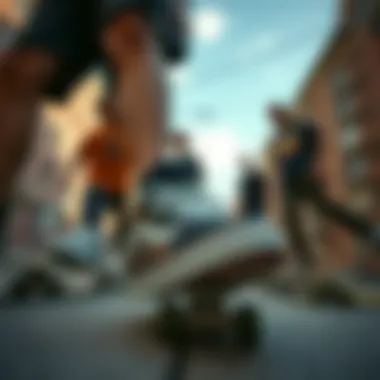

Tiger shoes often embrace bold designs and vibrant colors, appealing to those who are keen on making a statement. They challenge traditional notions of skate footwear while still maintaining an edge that resonates with the skate scene. Skaters wearing Tiger shoes can be perceived as trendsetters, willing to step outside the conventional parameters that often define skate culture.
"Wearing Tiger shoes is like owning your style. It’s about the freedom to innovate and redefine what skateboarding means in an urban landscape."
In this way, Tiger shoes symbolize a movement that encourages creativity and breaking free from norms. The influence extends beyond mere aesthetics; they spark conversations, evoke emotions, and inspire community through collective experiences.
Consumer Trends in Skate Footwear
Understanding consumer trends in skate footwear provides essential insights into the evolving landscape of skate culture. As skaters become increasingly discerning about the shoes they wear, various factors drive their preferences—ranging from style and function to environmental consciousness. In this section, we dive into these trends, highlighting their significance as the nexus between personal expression and cultural identity for skateboarders.
Market Preferences Between Brands
When it comes to skate footwear, the brands skaters choose often speak volumes about their personal identity and style. Vans and Tiger shoes, both hold strong positions in the market, yet they attract different segments of skaters.
- Vans often appeals to those who value classic aesthetics with a touch of contemporary flair. Their signature checkerboard patterns and durable canvas materials become synonymous with the skate lifestyle. Skaters appreciate how Vans provide both performance and style, leading to significant market loyalty.
- On the other hand, Tiger shoes cater to skaters who lean towards innovative designs and high-quality performance. The unique configurations of the sole and sole grip often catch the eye of performance-oriented skaters, enabling them to push their limits without sacrificing comfort.
Skateboarding is not just a sport but a lifestyle, and skaters are less likely to choose a brand solely based on performance metrics. They consider aspects like collaborations, testimonies from peers, and, importantly, how the brand aligns with their values.
The Shift Towards Sustainability
As awareness grows around environmental issues, the skate footwear market is seeing a shift towards sustainability. Skaters are becoming more vocal about where their shoes come from and the impact on the planet. This trend isn't a passing fad—it's reshaping the way brands like Vans and Tiger design and market their products.
- Eco-friendly materials are gaining traction within skate shoes. Skaters now look for options that include sustainable fabrics and recycled components, thus pushing brands to innovate and adapt their production methods.
- Transparency in production is another aspect that influences consumer choices. Skaters prefer brands that share their story, detailing the journey of their shoes from design to delivery. This openness cultivates trust and loyalty, making it crucial for companies to practice ethical sourcing.
"Consumers today are well informed, and their purchasing decisions reflect a commitment to sustainability and social responsibility. Companies that ignore this trend in skate culture risk falling behind."
In summary, consumer trends in skate footwear reflect a multifaceted relationship between identity, performance, and environmental awareness. As skaters embrace their individuality while navigating an increasingly complex market, brands are challenged to evolve. The dialogue around market preferences and sustainability will shape the future of skate footwear choices, ensuring that Vans and Tiger shoes remain integral to this dynamic culture.
Future Outlook for Vans and Tiger Shoes
Understanding the future of Vans and Tiger shoes in the realm of skate culture is not just about observing trends; it's about grasping the underlying currents shaping the entire scene. As skateboarding continues to evolve, the footwear designed for it must adapt too. This section dives into those anticipated changes and strategic roadmaps both brands could take to stay relevant amidst shifting consumer preferences and technological advancements.
Anticipated Trends in Skate Footwear
As we look ahead, several trends are brewing in the skate footwear market, reflecting broader societal movements and the changing landscape of skateboarding itself. These include:
- Emphasis on Sustainability: Many consumers today are increasingly concerned about environmental issues. Brands are moving towards using sustainable materials, like recycled plastics and organic cotton, as well as implementing eco-friendly manufacturing processes. This trend might not only satisfy eco-conscious skaters but could also differentiate brands in a crowded marketplace.
- Customization Options: The desire for personal expression among skateboarders is climbing. Offering customizable shoe designs can attract buyers looking to showcase their unique styles. Whether through color choices or adding patches, customization can provide a deeper connection to the product.
- Technological Integration: Integration of innovative tech in footwear is on the rise. From enhanced grip soles to cushioning systems that absorb shock better, technological advancements can significantly influence performance. The increasing role of wearable technology might also merge with skate footwear, creating shoes that give feedback on performance or health.
- Gender-Neutral Styles: With more people embracing fluidity in gender identity, skate brands might see a shift towards unisex footwear designs. Offering options that cater to all genders could help expand the customer base.
“In the future, sustainability isn't a buzzword; it’s expected. Brands must be ahead to stay afloat.”
These trends signal a significant shift for both Vans and Tiger shoes. While Vans leans into a heritage style fused with modern sensibilities, Tiger shoes might capitalize on sleek designs targeting urban skaters, blending performance and aesthetics.
Strategic Directions for Both Brands
To maintain their foothold in skate culture, Vans and Tiger shoes need to adopt strategic directions that resonate with both their heritage and the demands of the modern skater. Here are potential pathways:
- Collaborative Ventures: Collaborations with prominent skateboarders and other streetwear brands can bolster brand visibility. Limited edition releases or co-branded shoes could create buzz around both companies.
- Community Engagement: Actively participating in skate events and local competitions can strengthen brand loyalty. Offering sponsorships or hosting clinics not only fosters community connections but also aligns the brand with emerging talent.
- Expansion into E-Commerce: In a digital-first world, optimizing online shopping experiences can capture the attention of tech-savvy skaters. Enhancing websites and social media presence with engaging content will allow these brands to engage a wider audience.
- Focus on Performance: Both brands should continue to delve into the performance element of skate footwear, using feedback from professional skaters to refine products. Shoes that enhance both skateboarding experience and comfort can keep users loyal.
As the wheels of skateboarding continue to turn, Vans and Tiger shoes stand at a critical juncture. Embracing the anticipated trends and strategically navigating the challenges will significantly impact their roles in skate culture moving forward.
End and Final Thoughts
As we wrap up this exploration into the fascinating dynamics between Vans and Tiger shoes in the skate culture realm, it’s important to spotlight how these two brands have carved their own niches while also impacting the broader landscape of skateboarding footwear. Understanding this relationship goes beyond mere aesthetics or brand loyalty—it unveils layers of cultural significance and personal expression within the skate community.
Summarizing Key Insights
Both Vans and Tiger shoes, each rooted in unique histories and philosophies, cater to the diverse needs of skateboarders. Vans, synonymous with classic skate culture, leans heavily on its historic legacy and a loyal following that spans generations. In contrast, Tiger shoes emerge with fresh innovation and a focus on performance that appeals to a new wave of skaters seeking something different.
Several key insights arise from this analysis:
- Cultural Impact: Vans holds a legacy that many associate with skateboarding's rise in mainstream popular culture. Meanwhile, Tiger shoes present a counter-narrative, emphasizing performance and contemporary design approaches.
- Consumer Preferences: Skateboarders today aren't just looking for footwear that looks good; they prioritize comfort, durability, and technological features. The competition between these brands creates a richer selection for enthusiasts.
- Brand Collaborations: Unique partnerships and limited editions enhance the appeal of both brands, showing that in skate culture, creativity knows no bounds.
"The synergy between style, functionality, and identity in skate shoes defines the essence of the culture itself."
The Ongoing Evolution of Skate Footwear
The evolution of skate footwear is not a static tale. It is a narrative that evolves with changes in technology, skateboarding techniques, and cultural trends. Brands like Vans and Tiger shoes are continuously adapting to these shifts, ensuring they resonate with the current generation of skaters. Looking ahead, we can expect:
- Sustainability Initiatives: As consumer awareness increases, both brands are likely to engage in more sustainable practices to appeal to environmentally conscious skaters.
- Integration of Technology: From smart materials to enhanced cushioning systems, future footwear will probably focus on integrating technology that can support skaters in their performance.
- Cultural Fusion: The blending of skate culture with streetwear and high fashion will see future designs pushing the envelope of traditional skate aesthetics.











